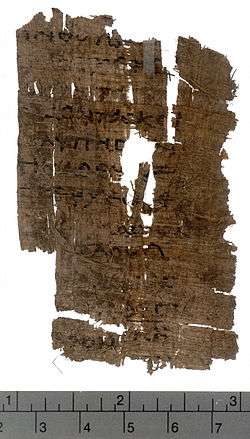Gospel of Marcion

The Gospel of Marcion, called by its adherents the Gospel of the Lord, was a text used by the mid-2nd-century Christian teacher Marcion of Sinope to the exclusion of the other gospels. So many Christian apologists wrote treatises against Marcion after his death that it has been possible to reconstruct almost the whole of Marcion's Gospel of the Lord from their quotations. Its reconstructed fragments now appear among the New Testament apocrypha.
Relationship to the Gospel of Luke
There are two possible relationships between Marcion's gospel and the Gospel of Luke: either Marcion revised a previously existing Gospel of Luke to fit his own agenda, or his "Gospel of the Lord" predated, and was a source for, the Gospel of Luke.
Marcion's gospel as a revision of Luke's
Church Fathers wrote, and the majority of modern scholars agree,[2][3] that Marcion edited Luke to fit his own theology, Marcionism. The late 2nd-century writer Tertullian noted that Marcion, "expunged [from the Gospel of Luke] all the things that oppose his view... but retained those things that accord with his opinion".[4]
According to this view, Marcion eliminated the first two chapters of Luke concerning the nativity, and began his gospel at Capernaum making modifications to the remainder suitable to Marcionism. The differences in the texts below highlight the Marcionite view that Jesus did not follow the Prophets and that the earth is evil.
| Luke | Marcion |
|---|---|
| O foolish and hard of heart to believe in all that the prophets have spoken (24:25) | O foolish and hard of heart to believe in all that I have told you |
| They began to accuse him, saying, ‘We found this man perverting our nation . . .’ (23:2) | They began to accuse him, saying, ‘We found this man perverting our nation . . . and destroying the law and the prophets.' |
| I thank Thee, Father, Lord of heaven and earth... (10:21) | I thank Thee, Heavenly Father... |
Late 19th- and early 20th-century theologian Adolf von Harnack, in agreement with the traditional account of Marcion as revisionist, theorized that Marcion believed there could be only one true gospel, all others being fabrications by pro-Jewish elements, determined to sustain worship of Yahweh; and that the true gospel was given directly to Paul the Apostle by Christ himself, but was later corrupted by those same elements who also corrupted the Pauline epistles. In this understanding, Marcion saw the attribution of this gospel to Luke the Evangelist as a fabrication, so he began what he saw as a restoration of the original gospel as given to Paul.[5] Von Harnack wrote that:
For this task he did not appeal to a divine revelation, any special instruction, nor to a pneumatic assistance [...] From this it immediately follows that for his purifications of the text - and this is usually overlooked - he neither could claim nor did claim absolute certainty.[5]
Marcion's Gospel as a proto-Luke
While it remained a minority hypothesis throughout the 18th, 19th, and 20th centuries, Biblical scholars as varied as Johann Salomo Semler,[6] Johann Gottfried Eichhorn,[7] Albrecht Ritschl,[8] John Knox,[9][10] and Joseph B Tyson[11] posited that the Gospel of Luke was a later redaction of the Gospel of Marcion, rather than the other way around.
In 2008, Matthias Klinghardt proposed a new solution to the synoptic problem involving the Gospel of Marcion, in which the Gospel of Marcion was based on the Gospel of Mark, the Gospel of Matthew was an expansion of the Gospel of Mark with reference to the Gospel of Marcion, and the Gospel of Luke was an expansion of the Gospel of Marcion with reference to the Gospel of Matthew.[12]
References
- ↑ Clivaz, C., The Angel and the Sweat Like 'Drops of Blood' (Lk 22:43–44): P69 and f13, HTR 98 2005), p. 420
- ↑ Ehrman, Bart (2003). Lost Christianities. New York: Oxford University Press. p. 108.
- ↑ Metzger, Bruce. The Canon of the New Testament: Its Origins, Developments and Significance. Oxford: Clarendon Press.
- ↑ Tertullian, Adversus Marcionem 4.6.2
- 1 2 Adolf von Harnack: Marcion: The Gospel of the Alien God (1924) translated by John E. Steely and Lyle D. Bierma
- ↑ Semler, Johann (1783). Thomas Townsons Abhandlungen über die vier Evangelien. Leipzig.
- ↑ Eichhorn, Johann (1820). Einleitung in das Neue Testament. Leipzig: Weidmann. pp. 72–84.
- ↑ Ritschi, Albrecht (1846). Das Evangelium Marcions und das kano nische Evangelium des Lucas. Eine kritische Untersuchung. Tübingen: Buchhandlung Osiander.
- ↑ Knox, John (1942). Marcion and the New Testament: An Essay in the Early History of the Canon. Chicago: Chicago University Press. ISBN 978-0404161835.
- ↑ Knox, John (1987). Jesus, the Gospels, and the Church: Essays in Honor of William R. Farmer. Macon: Mercer University Press. pp. 25–31.
- ↑ Tyson, Joseph (2006). Marcion and Luke-Acts: A Defining Struggle. University of South Carolina Press. pp. 25–31. ISBN 978-1570036507.
- ↑ Klinghardt, Matthias (2008). "The Marcionite Gospel and the Synoptic Problem: A New Suggestion". Novum Testamentum. 50 (1): 1–27. JSTOR 25442581.
External links
- The Marcionite Research Library: contains a full text in English with hyperlinks to the reconstruction sources.
- G.R.S. Mead, Fragments of a Faith Forgotten (London and Benares, 1900; 3rd edition 1931): pp. 241– 249 Introduction to Marcion
- History of the Christian Religion to the Year Two-Hundred by Charles B. Waite: It includes a chapter where he compares Marcion and Luke
- Marcion and Luke-Acts: A Defining Struggle by Joseph B. Tyson A case in favor of the view that the canonical Luke-Acts duo is a response to Marcion. Tyson also recounts the history of scholarly studies on Marcion up to 2006.
